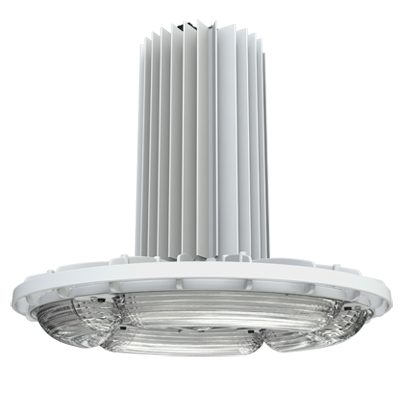Specifier’s Guide: Holophane Glass vs. Plastic Reflectors
6-16-20 Plastic reflectors have made great inroads into lighting large spaces over the past several years and it now seems that they are marginally acceptable in certain applications. However, there are still significant limitations to their use.
Issue: Acrylic and Product Life
- Acrylic is a thermo plastic, deforming and discoloring under conditions of high heat and UV exposure.
- Limit is 80 C continuous service temperature; higher temperatures cause premature failure.
- Effects of ambient temperature on continuous temperature:
- For every degree above rated ambient, subtract 1C from continuous service temperature.
- Operating above rated ambient affects ballast life. With plastic reflectors, it also affects reflector life.
- Manufacturers warn against use in areas where reflector is subject to impact, such as gymnasiums.
Summary: Plastic reflectors will experience life cycle problems in environments where heat, UV exposure and impact are problems.

Issue: Dirt Depreciation
- Glass is electrically inert and will not attract dust. In moderately dirty environments, Prismalume can use a 3% per year depreciation factor.
- Plastic reflectors attract dust. IES standards call for a 7% per year depreciation factor.
Summary: Include an additional 4% dirt depreciation difference for plastic reflectors.
Issue: Requirement for Coated Metal Halide Lamps
- Acrylic reflectors are injection molded and have extremely sharp prisms.
- Lexalite recommends all plastic reflectors use coated lamps to overcome sharp prism problems.
- Coated lamps are more expensive than clear. Further, maintenance must relamp with coated lamps or risk performance damage using clear lamps.
- Clear lamps in plastic reflectors exhibit spike and donut problems. Specifically, they have much reduced output at nadir and cause rings of light on the floor.
- 3 out of 4 lamp manufacturers document higher maintained lumens for clear lamps than for coated. On average, there is a 4% maintained lumen difference.
Summary: Include an additional 4% depreciation factor for coated lamps when compared to clear lamps unless specific lamp vendor information is provided.
Summary:

- Plastic reflectors show performance losses due to excess heat and impact. They are not suitable for high heat or high impact probability areas.
- Dirt depreciation losses are about 4% more than Holophane reflectors.
- Lumen depreciation losses using coated lamps are about 4% greater than clear lamped Holophane luminaires.
- Total depreciation for plastic reflectors should be 8% greater than for Holophane glass reflector luminaires.
Share This Post
